Brand Strategy Discovery Template
Brand Strategy Discovery Template
Originally published in 2018, this post has been updated to reflect our current thinking related to brand strategy. Here, we've created an even simpler, more streamlined process, as well as our free Brand Strategy Toolkit to guide you through. We hope you find it helpful.
If there's one thing we've learned from over a decade of helping brands tell their story, it's that a successful business can't survive if it doesn't have a strong brand strategy. Without a unified identity, everything from your content, to your culture, to your core business can suffer. But there's a reason why this problem is so pervasive: Building a strong brand strategy takes time, effort, and commitment. And that's where many people (including ourselves) can get stuck.
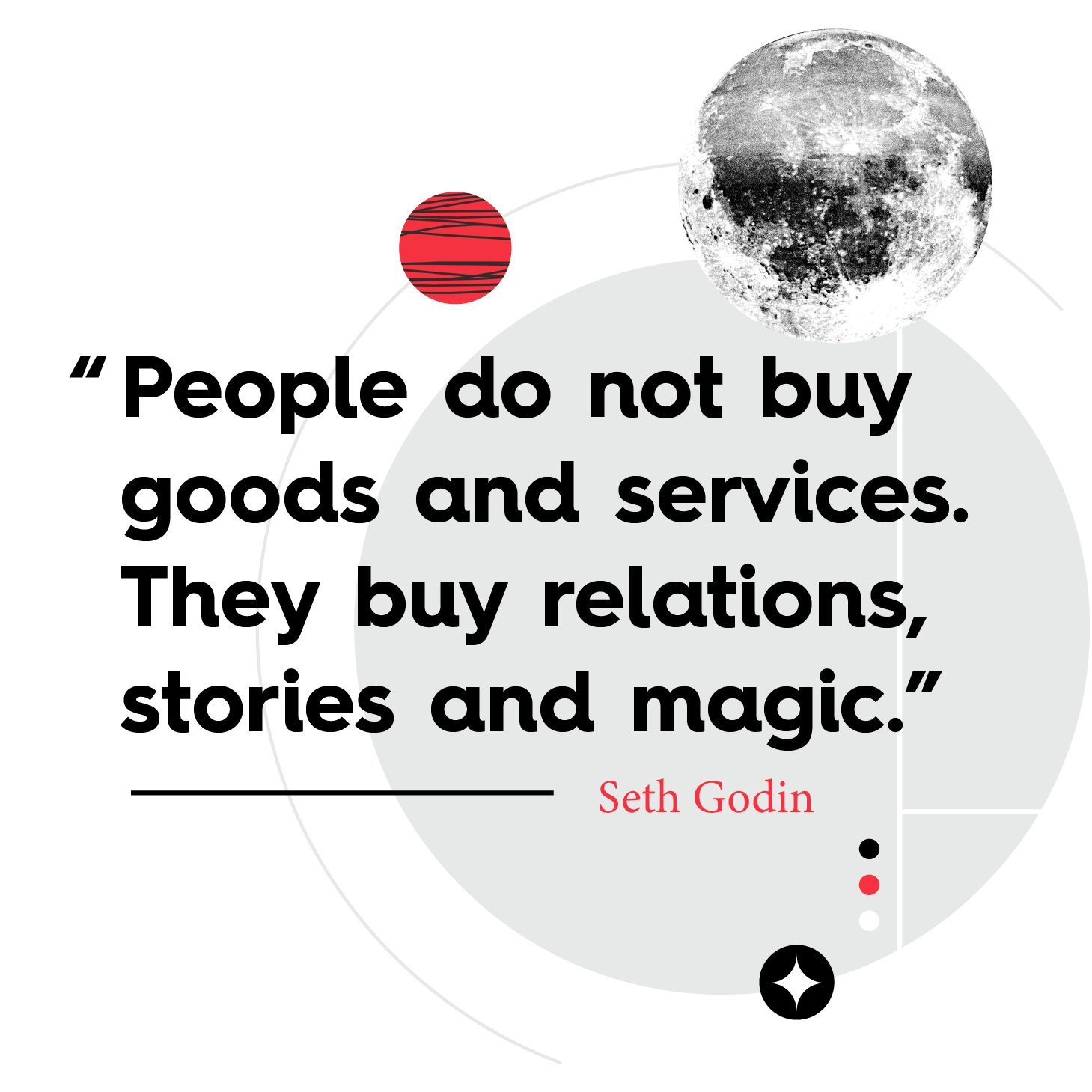
The Beginning of Our Brand Strategy
We started doing brand strategy work a few years back after encountering various clients who came to us for content strategy work but couldn't articulate who they were or what they were really trying to achieve. We soon realized they needed more than content help; they needed a total brand realignment. We were eager to help guide them, but we also had two big realizations:
- Brand strategy work seems really complicated—and it shouldn't be. Once we started learning more about brand strategy, we ran into so many schools of thought, conflicting perspectives, and outdated exercises. If we wanted to give our partners a simple framework, we'd have to create it ourselves.
- We didn't know our own brand as well as we thought we did. The more we explored our clients' brand problems, the more we realized we were struggling with many of the same issues. If we wanted to confidently guide our clients through the brand strategy framework we created, we'd have to be the guinea pig and test it on ourselves first.
So we dug in, got dirty, and did the work. Thankfully, after an entire year of tweaking and testing (first on ourselves, then with a few brave clients), we emerged with a tried-and-true brand strategy process that was simple, intuitive, and adaptable for any brand of any size. Was it easy? Absolutely not. Was it worth it? Oh yeah.
We think it'll be worth it for you, too. In this guide, we've taken everything we've learned about brand strategy—the books, podcasts, articles, and personal experience—and distilled it down into a simple step-by-step process to create an effective, flexible brand strategy that will help you…
- Understand who you truly are and use your beliefs and values to guide your decisions in ways that are better for your people, your business, and the future.
- Communicate your brand consistently and effectively through every piece of content you make.
- Attract the right customers to build a strong, lasting brand.
- Position your brand in a way that helps you compete now—and tomorrow.
To make it easy, we've included the tools, resources, and real-life examples you need to get through the brand strategy process, from finding your Brand Heart to creating the brand guidelines to express it.
You'll want to start by downloading our freeBrand Strategy Toolkit (below), which includes handy templates, questionnaires, and checklists to help you throughout the process.
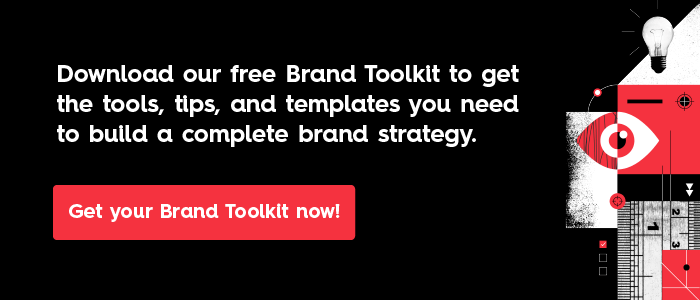
As you work through this guide, follow the steps sequentially (as each builds on the previous), and you'll finish with a basic brand strategy that can grow with you as your brand evolves.
Table of Contents
- What Is a Brand?
- What Is a Brand Strategy?
- Why Do You Need a Brand Strategy?
- What Team Do You Need to Build Your Brand Strategy?
- What to Know Before You Start Your Brand Strategy
- How to Build Your Brand Strategy
- Part 1: Find Your Brand Heart
- Purpose
- Vision
- Mission
- Values
- Part 2: Articulate Your Messaging
- Brand Essence (Personality, Voice, Tone)
- Value Prop
- Tagline
- Messaging Pillars
- Part 3: Design Your Visual Identity
- Logo
- Typography
- Color
- Imagery
- Illustration
- Photography
- Part 4 : Create Your Brand Guidelines
- Verbal
- Visual
- Part 1: Find Your Brand Heart
- How to Bring Your Brand Strategy to Life
What Is a Brand?
There are a million definitions of a "brand." Often, when people talk about a "brand," they're referring to the physical mark (or logo) imprinted on something to identify the business that manufactured it. But a brand is more than a physical mark. It's an emotional mark—more specifically, an emotional experience, strengthened or weakened through every interaction with that business.
We define brand as what people think, feel, and say about your business. (This differs from marketing, which is what you say about your business.)
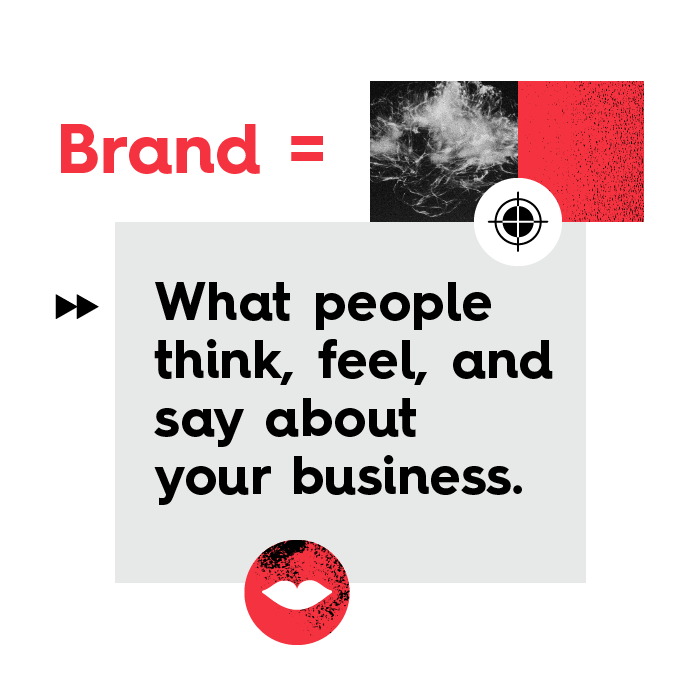
What Is a Brand Strategy?
As branding guru Marty Neumeier says, a brand strategy is "a plan for the systematic development of brand in alignment with a business strategy."
A brand strategy helps you understand who you are and acts as a blueprint to help you communicate it.
Our brand strategy process is broken into three distinct parts. We guide you from your Brand Heart (the core of your brand), to the articulation of your Brand Messaging (how you talk about who you are), to your Visual Identity (the visual expression of your brand). By the end, you'll have a full brand strategy, summed up in fresh brand guidelines to help you bring your brand to life.
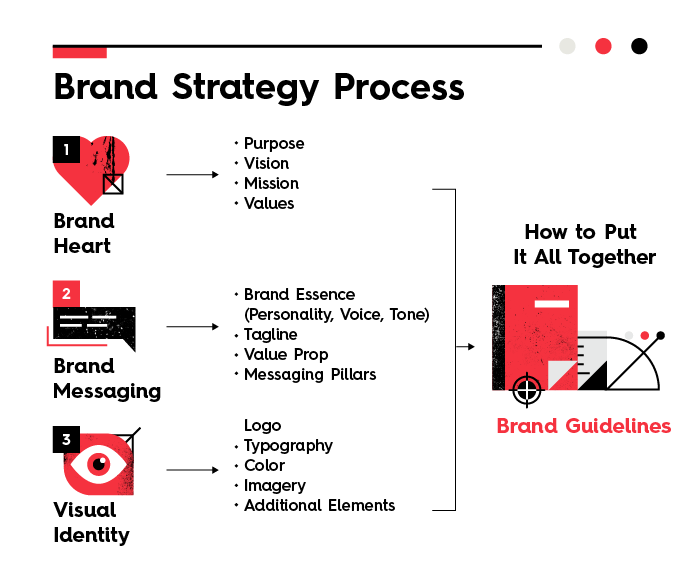
Why Do You Need a Brand Strategy?
When you don't know who you are, why you exist, what you believe in, or what you're trying to achieve, your business suffers. From customer communication issues to employee retention, a lack of brand strategy causes problems at every level of an organization.
Having worked with hundreds of clients over the last decade, we've learned to spot the telltale signs of a brand in crisis, often caused by a lack of strategy. (Some of these issues might sound familiar to you. Before we documented our brand strategy, we suffered from them too.)
When you have no brand strategy…
- You don't understand your purpose, vision, mission, or values, so you make marketing and business decisions that don't reflect them.
- You don't have a documented marketing plan, but you hope that whatever you're doing will work.
- Your team is fractured by disunity, confusion, and conflict, making it hard for employees to feel engaged and interested.
- You don't have cohesive brand messaging, so your content tends to be inconsistent at best, and contradictory at worst. As a result, it's difficult to attract people who share your values (customers, employees, etc.).
- You can't clearly articulate your brand, and as a result, you can't carve out a discernible place in the market.
In short, without a brand strategy, you lose.

What Team Do You Need to Build Your Brand Strategy?
You can't build a brand strategy alone. You need a brand team to craft, revise, and bring it to life at every level of your organization. Without this designated team, the work you do here will likely get sidetracked or steamrolled.

Luckily, you don't have to hire a ton of people to form your brand team. You can even have a two-person team, so long as both people can cover these essential roles.

What to Know Before You Start Your Brand Strategy
If you're starting your brand strategy from scratch (or trying to do things the "right" way this time), there are two key pieces of information you need to know beforehand. (If you've done your business strategy, you know these already.) They are:
1) Who You're For
Who are you trying to sell to? What do they need/want? How are their needs not being met?
To build a brand strategy that helps you genuinely connect with people, you need to know exactly who you're selling to. Knowing who they are and how you're trying to serve them can actually bring clarity to who you are (e.g., your Brand Heart) and how you communicate with them.
HOW TO DO IT
If you don't know who you're for, use the Personas Template in the Brand Toolkit, and follow our Guide to Create Personas.
2) Who You're Against
Who shares your space? Who will you be competing with for attention? How might they outshine you?
This is invaluable information to help you identify who you are and who you aren't, how you fit in or stand out, and how you can communicate your differences through your brand strategy.
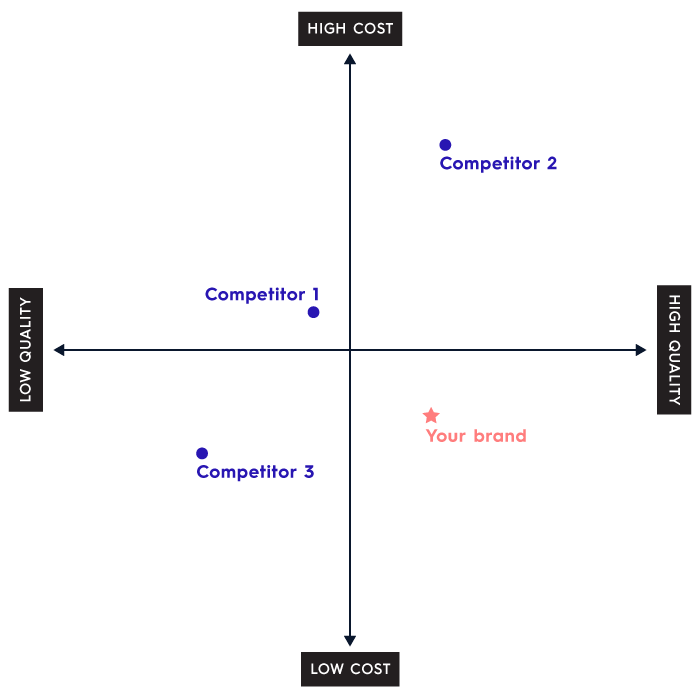
HOW TO DO IT
Use the Competitive Analysis Template in the Brand Toolkit, and follow our Guide to Complete Your Competitive Analysis.
Once you have this information, you're ready to dive into your brand strategy.
How to Build Your Brand Strategy
Follow these steps sequentially (as each builds on the prior), and you'll end up with a comprehensive brand strategy that helps you share your story impactfully and effectively at every touchpoint.
Part 1: Find Your Brand Heart
Every brand holds a basic set of beliefs that influence everything they do. We call these beliefs your Brand Heart. Knowing what these principles are and why they matter is imperative, as they are a powerful, potent force that can actively support or sabotage your business. When your brand's beliefs and business are aligned, you can successfully bring people together, cultivate community, and create the future you want. When you have no beliefs (or those beliefs are toxic), you can easily alienate both employees and customers, cripple your culture, and make decisions that derail your long-term goals.
Your Brand Heart is comprised of four elements that help you clarify who you are, what you do, and why it matters.
- Purpose: Why do we exist?
- Vision: What future do we want to help create? What does the future look like?
- Mission: What are we here to do? How do we create that future?
- Values: What principles guide our behavior?
HOW TO DO IT
Use the Brand Heart Workbook in the Brand Toolkit, and follow our Guide to Complete Your Brand Heart.
Note: While your Brand Heart is often an internal document, it can be translated into external-facing messaging everywhere from your website to your packaging, which is why it's so important to have it nailed down from the beginning.
Part 2 : Articulate Your Messaging

Now that you have your Brand Heart documented, you know who you are. Next you need to figure out your Brand Essence (how to express who you are) and your Brand Messaging (how to talk about who you are). When you distill and document these elements effectively, you can ensure your brand will communicate honestly, authentically, and consistently.
Note: Some brands are tempted to skip straight to designing their visual identity (logo, colors, etc.) once they have their Brand Heart, but we would argue that there are a few crucial steps to complete before that. Things like your logo, colors, and typography are vital to your brand, but they're ultimately a visual translation of your brand's essence and messaging. If you don't know what you're trying to communicate, it's difficult to create a visual identity to embody it.
That said, you may already have created your visual identity before you solidified these elements. (Full disclosure, that's what we did too—many years ago.) But if you're doing this work now, it's important that your heart, messaging, and visual identity align—no matter the order in which you tackle them.
PSST! DO YOU HAVE A BRAND NAME?
We're assuming you do. But if you don't, find out How to Choose the Perfect Brand Name.
Create Your Brand Essence
Your Brand Essence consists of your:
- Personality
- Voice
- Tone
Identifying these elements can seem intimidating, but it's not a chore. It's not even a hunt. Your essence is inherent. It doesn't need to be manufactured; it simply needs to be unearthed and documented with some intention.
1) Identify your personality. Your personality is basically your brand's human characteristics and attributes. Are you curious and enthusiastic? Elite and sophisticated? Wild and crazy? Your personality is a reflection of your Brand Heart, influenced by your beliefs and demonstrated in your behavior. When you have an intimate understanding of your personality, you can infuse it into every aspect of your brand, from your customer service process to your product descriptions. This is a powerful way to differentiate yourself and cultivate relationships.
HOW TO DO IT
Follow our Guide to Find Your Brand Personality.
2) Identify your brand voice. This is the way your brand sounds and speaks. Remember that every brand voice is unique. A yogurt brand doesn't speak the way a car brand speaks, and one car brand sounds different than another. Your personality already influences your brand voice; you just need to articulate it so that you can communicate consistently in your content.
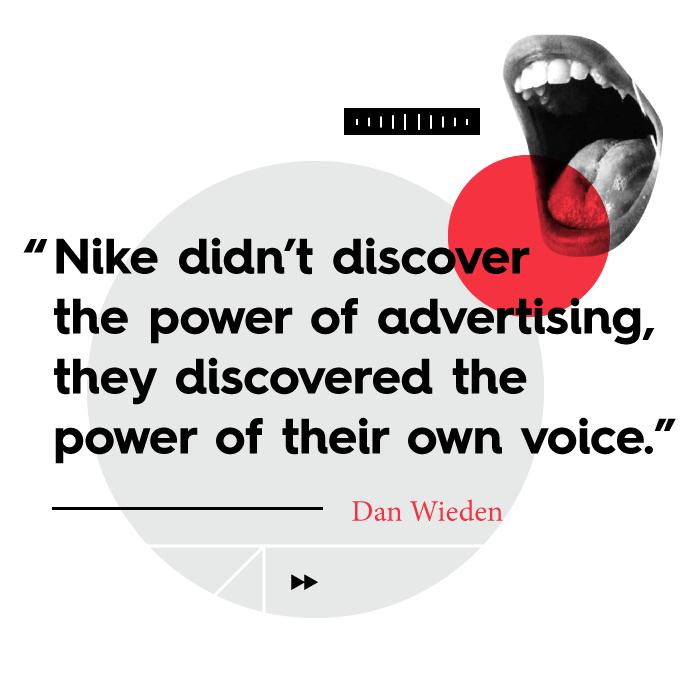
HOW TO DO IT
Use the Brand Voice Template in the Brand Toolkit, and follow our Guide to Find Your Brand Voice.
Remember: The words, phrases, slang, and jokes you use communicate your identity in both direct and indirect ways. Think about how you want to speak—and how your customers want to be spoken to.
3) Identify your tone. You brand's tone is basically y our general attitude. Your voice may be authoritative, but the tone is respectful. Think of your brand's voice as how you talk, and your tone as how you talk in different contexts. You always use the same voice, but you may shift your tone depending on who you're talking to.
HOW TO DO IT
If you're not sure exactly what your tone is, think of how you want to make people feel. Should you talk to them like you're a helpful and kind neighbor, or a mysterious and aloof lover? To start, choose at least 3 words to describe your tone. (For example, Uber describes their tone as "Optimistic, inviting, bold.")
With your Brand Essence articulated, you have formed a basis for communicating who you really are at every touchpoint, from the pop-ups on your site to your Twitter feed. (The brands that do this best are the ones we love the most—no matter what they're selling.)

Create Your Brand Messaging
There are many ways to talk about who you are, what you do, and why people should choose your brand over your competition. For the purposes of this brand strategy, we're starting with the most basic messaging: your value prop , tagline, and messaging pillars .
1) Articulate your value prop. Your value prop is a succinct explanation of both the functional and emotional benefits your product or service provides to customers. It's not just who you are and what you do differently (your positioning); it's also how you solve their problem and why they should choose you over the competition.
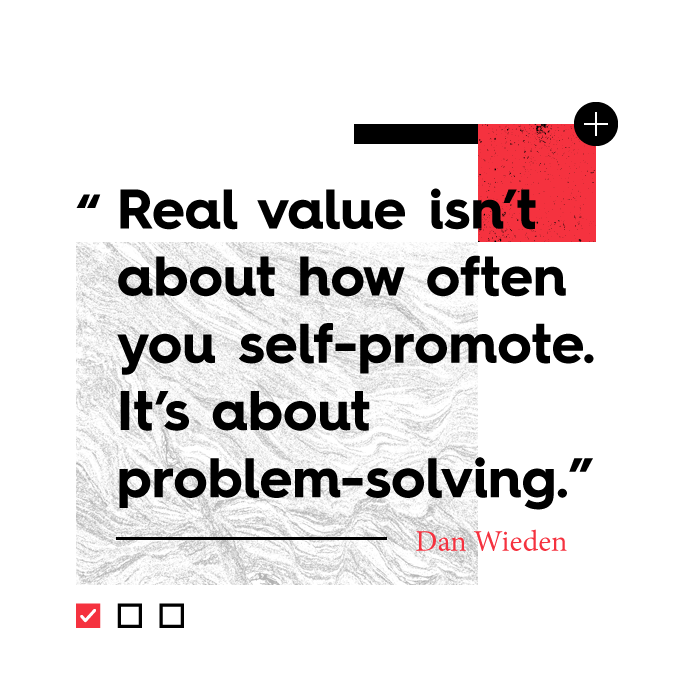
You can also think of it as the promise of what your customer will receive if they buy from you. If you want your brand to succeed, you need to have the answer to this question before anyone asks. Going forward, it's what all your messaging will ultimately support and reinforce.
HOW TO DO IT
Use the Brand Messaging Template in the Brand Toolkit, and follow our Guide to Write a Great Value Proposition.
2) Distill your tagline. Your tagline is a sentence, phrase, or word used to summarize a market position. Coming up with a great tagline isn't like the movies. Most companies don't have a Don Draper to simply feed you the perfect line. It's usually a long slog through brainstorms and iterations. Luckily, researchers are discovering the keys to a great tagline, offering interesting insights that can help you choose the perfect one.
HOW TO DO IT
Use the Brand Messaging Template in the Brand Toolkit. Follow our Guide to Write a Great Tagline, and check out these 13 Unique Tagline Examples for inspiration.
2) Identify your messaging pillars. Your messaging pillars are the key stories you want to tell about your brand—what makes you unique and different. Every piece of content you create should reinforce these core messages across all touchpoints.
HOW TO DO IT
Use the Brand Messaging Template in the Brand Toolkit, and follow our Guide to Create Your Brand Messaging.
Depending on your brand's needs, you may want to articulate additional messaging elements, including:
- Brand promise
- Brand story
- Manifesto/compact
- Origin or founder story
- Elevator pitch
Part 3: Design Your Visual Identity

When most people think of branding, they think of a brand's visual identity: the logo, colors, typography, and other elements that act as the "face" of the brand. Now that you've crystallized your heart and messaging, it's time to visualize it with the basics:
- Logo
- Typography
- Color
- Imagery
A strong visual identity is meant to be purposeful, first and foremost. You aren't just designing for today. You're designing for your brand's future. Thus, a good visual identity is:
- Flexible: It should be able to grow with your brand, whether you're branching out into new products, services, or even new industries.
- Comprehensive: It should provide brand designers and content creators with the tools they need to properly do their job.
- Intuitive: It should be intuitively designed and well constructed so that each element complements the other.
Note: Depending on your brand, you may need to expand your visual identity over time. If so, you might consider adding guidelines for additional visual elements.
Logo
A good logo is a memorable logo, and research shows that the most memorable logos are the simplest logos. You want it to reflect your brand, yes, but keep it simple if you want it to make an impact. You also need to consider how people visually process and assign meaning to images, as research has found that people assign different attributes to different shapes.
HOW TO DO IT
To start, use the Visual Identity Checklist in our Brand Toolkit to ensure you design a comprehensive visual identity. Follow our Guide to Design a Logo You Love, and make sure to avoid the 7 Most Common Logo Design Mistakes.
Typography
Typography is an extension of your logo; hence, we start with logo design first. However, typography is more important than ever, as people are consuming words in multiple mediums. That said, something that works on your packaging may not work well on your website, so it's important to consider not only how your typography aligns to your brand but the many applications it will be used for.
HOW TO DO IT
Follow our Guide to Find the Right Typography for Your Brand.
Colors
Color is one of the most powerful yet mystifying elements of branding. Research suggests it can affect everything from brand perception to purchasing intent, yet it is a bit of a tricky science. Not all colors evoke the same things in everyone because our associations with color are very subjective.
HOW TO DO IT
Follow our Guide to Choose the Right Brand Colors.
Imagery
Imagery is more important than ever, now that so much of your brand is communicated through visual media. Whether you choose photography, illustration, or a combination of both, everything should align to your brand.
Illustration
Developing a unique illustration style is a smart way to visually brand your content, but don't go overboard. You want a style that is clear, distinct, and on-brand. Also, don't mix styles or clutter illustrations with visual junk.

Photography
Photography is an effective, versatile tool that is less time-intensive to design. However, you need a clear aesthetic to keep it consistent with your brand. You should also consider the resources available to you. Luckily, there are plenty of sources to choose from.
- Stock sites (free): There is a ton of free, high-quality stock photography online, and you can easily create unique design treatments that turn a bland stock image into a photograph that communicates your brand. (Pexels, Unsplash, and StockSnap.io are great places to start.) Just make sure you clearly lay out the dos and don't for things like filters, design treatments, resolution, etc.
- Image licenses (paid): There are a variety of photo services that let you license photos individually or as a subscription. They're less likely to show up on your competitors' site, but it can still happen as anyone can purchase them. Check out Shutterstock, Adobe Stock, and Alamy if you want to go this route.
- Custom (free or paid): We are living in a golden age of creation, thanks to the amount of creative tools available to everyone. You can commission photography or let your team handle it, so long as they have the skills and tools to create high-res images.
MORE VISUAL IDENTITY RESOURCES
For more tips and resources to create each element of your visual identity:
- Follow our Guide to Create a Powerful Brand Identity .
- Bookmark these 75+ Tools, Resources, and Tips to Build a Brand Identity .
- Get inspired by these 15 Brands with a Strong Visual Identity .
Part 4 : Create Your Brand Guidelines
Your brand guidelines serves as a playbook for how to use your brand, specifically in the content and communication you create. Maintaining quality and consistency can be a challenge, especially if you work freelancers or outside agencies. Thus, your brand guidelines should include enough direction to empower any creator to produce work that strengthens the brand instead of weakens it.
To ensure your brand guidelines are comprehensive, include direction for both your visual and verbal identity.
- Verbal guidelines
- Brand essence (personality, voice, tone)
- Tagline
- Value prop
- Messaging pillars
- Anything else helpful or relevant
- Visual guidelines
- Logo
- Color
- Typography
- Imagery (photography, illustration)
- Hierarchy
- Iconography
- Data visualization
- Interactive elements
- Video and motion
- Etc.
Remember: A brand's strength is determined by its consistency, or lack thereof.
HOW TO DO IT
Follow our Guide to Create a Brand Style Guide, and take a look at Column Five's interactive brand guidelines to see how we brought ours to life.
Once you've completed your guidelines, make sure you have a designated point person who can answer questions about applying the brand guidelines correctly, and make sure your guidelines are accessible to your team.
How to Bring Your Brand Strategy to Life
Now that you've completed the full brand strategy process, you can take a damn nap. Thanks to all your hard work, you officially have all the tools you need to communicate your brand story, align your brand and your business, and build the lasting relationships you need for long-term success. Of course, that work is never done.
To implement your brand strategy effectively going forward…
- Keep up on best practices. Check out our9 Favorite Books on Branding for more tips on effective branding.
- Create content that's aligned to your brand. Start with our Guide to Document Your Content Strategy.
- Master your content creation. Find out How to Improve Your Content Production at every stage.
- Tell your brand story at every touchpoint. Learn How to Tell Your Brand Story through every piece of content.
- Maximize your content reach. Follow ourGuide to Craft a Content Distribution Strategy to make sure your content gets in front of the right eyes.
Of course, we know this can all be a lot for any brand team, especially if you're short on time or resources. If so, consider bringing in help. Follow our tips to find a creative agency, and find out what it's like to work with us on your brand strategy. Or just holler at us . We'd love to help you tell your brand story.
Brand Strategy Discovery Template
Source: https://www.columnfivemedia.com/how-to-create-a-brand-strategy/


Tidak ada komentar:
Tulis komentar